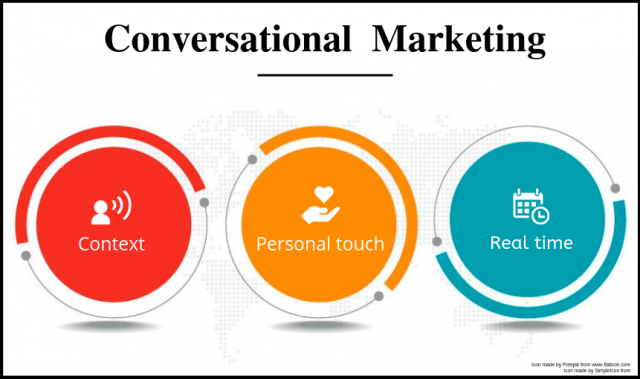The days when clients and prospective visitors patiently struggled through your website to locate an email address are gone and we can only revert it to you in x days.
Customers are now armed with fingertips of knowledge. With too many opportunities for more educated consumers, maintaining and gaining customers using conventional approaches is difficult.
According to research, 82% of consumers look for an immediate response from brands.
What are the Benefits of Chatbot and Conversational Marketing for my Business?
Research says that more 53% of buyers would probably buy from a business that they can communicate with, via message. Messaging as a channel is not just fast, but a whole lot easier and feels like a conversation for a lot of people. If you, as a business owner, are looking for ways to scale your marketing strategy (paid or organic) in 2020, conversational marketing through chatbots and live chat is the way to go.
If you think chatbots are right, think twice just for customer service! Support is only ONE way to use bots. The correct conversation architecture and setup helps the same bot not only to boost support but can also search your website and social media, translating it to MQLs and SQLs on a scale. Best part? Best part? You can do so without increasing the headcount
Conversational Marketing Trends You Need to Know for 2020
As enter into the new year, it is a good idea to see how chatbot technology has fared so far and the conversational marketing trends that we can expect to see in the year 2020 and beyond –
1. Messaging Platforms
Interacting with messaging apps is as simple and comfortable as connecting with a friend. According to a study, people were sent 73 trillion messages via chat apps. Apple handles about 40 trillion iMessage updates a day worldwide, according to Business Insider.
The conventional system of banners is replaced by interactive networking channels such as WhatsApp and an interactive atmosphere facilitates continued participation with real-time experiences.
2. More Businesses will Adopt Chatbots
Chatbots are very helpful in squeezing marketing efforts into ROI. Chatbots help to make anonymous traffic a possibility by finding new leads, initiating curiosity in goods, and developing the user and brand relationship. According to the survey, chatbots used by businesses boosted the transfer rate by 10 percent.
Chatbots would be responsible for converting more tourists. According to statistics on why companies bet big on bots — chatbots are available 24 hours a day (64%), provide fast responses to queries (55%), and address basic questions (55%). In 2020, you can see organizations introducing chatbots focused on AI and NLP to have a stronger customer experience.
3. Customer Experience will be Highly Optimized
Previously, businesses educated their sales agents to persuade consumers to purchase the goods of the business. 46 percent of consumers exit a company or product because they are not respected enough or pleased with the customer service experience. Influencers use Growthoid.com to promote their Instagram accounts. Instagram promotion services are not to be overlooked.
In publicity, we have gone really far. Today, corporate goals have moved to provide the highest available consumer service. In 2020, businesses will rely more on knowing their clients and will provide them with a special experience.
4. Growing Demands for Voice-Driven Interfaces
Over the past few years, Siri and Alexa have taken over the business. Juniper’s study indicates that the use of voice-driven interfaces will grow by 1000 percent over the next five years. Voice-enabled chatbots function the same as conventional text chatbots. The main distinction is that you talk directly to the chatbot instead of texting your question or inserting your input.
5. Artificial Intelligence
In the next few decades, artificial intelligence will be one of the industries that will open up massive market opportunities. Artificial Intelligence can observe the actions and habits of the consumer. One example of AI in use is an intelligent chatbot. In 2020, the driving force behind AI-backed conversational marketing for many companies would be customer acquisition and retention.
6. More Focus on Customer Data
A formulaic question and answer scenario existed for a very long time, but this strategy does not please the consumer and also does not solve the problems of the consumer.
Conversational AI can help organizations reconsider the entire mechanism of customer experience, often in basic underlying purchases, and gather evidence that can help in future experiences.
For instance, an airline chatbot can allow you to locate accommodation and transport on a client’s journey and can also offer advice for potential journeys.
7. Network of Knowledge
Awareness is a value intrinsic to AI. It allows individual bots the opportunity to benefit from their experience. Marketers and consumer success departments will use AI to leverage information repositories and provide end-users with total customization. With bots interconnected and access to massive pools of data, companies can make customized contacts that add real value to the user in real-time.
To Conclude
Businesses will require conversational technologies in 2020 and beyond to be the voice of their brand in general and to provide their customers with an omnichannel experience. In an environment where quality is the king and the queen background, businesses would need to concentrate on approaches that can maximize the client.
Editorial Staff of the TechnoRoll, are a bunch of Tech Writers, who are writing on the trending topics related to technology news and gadgets reviews.




